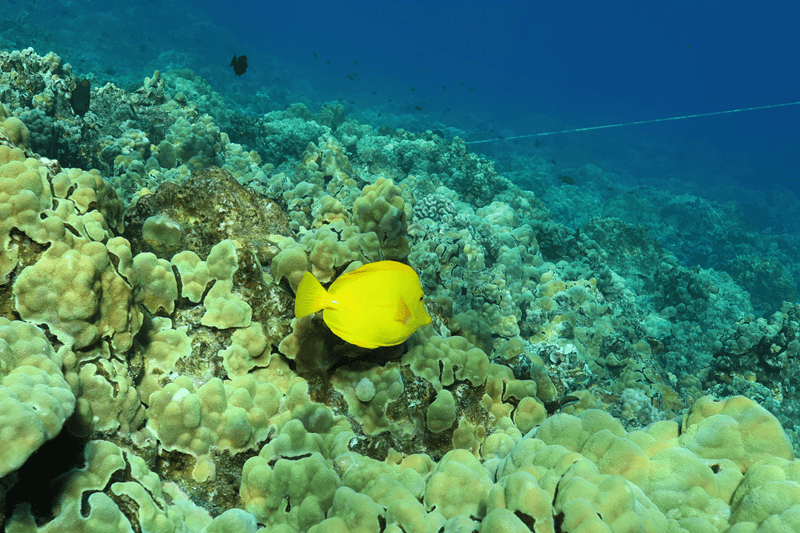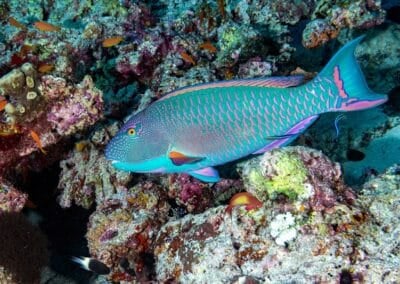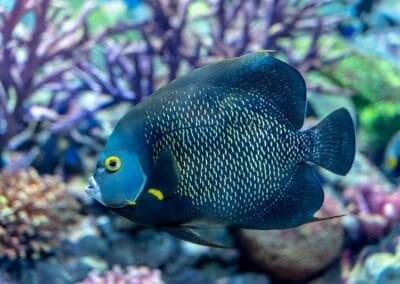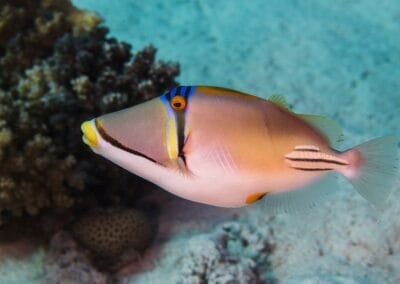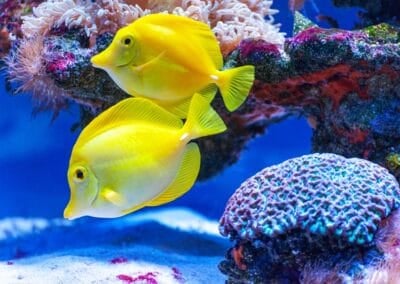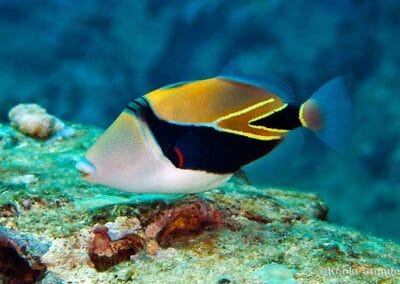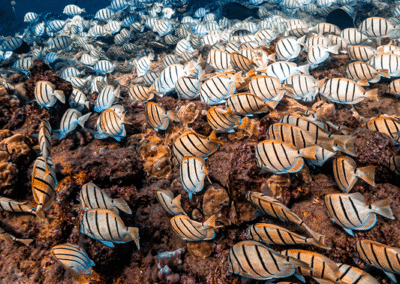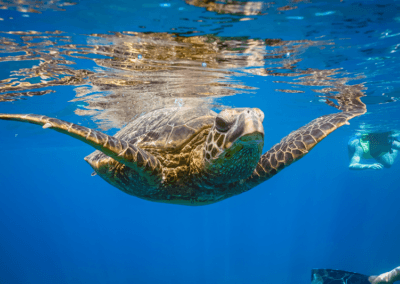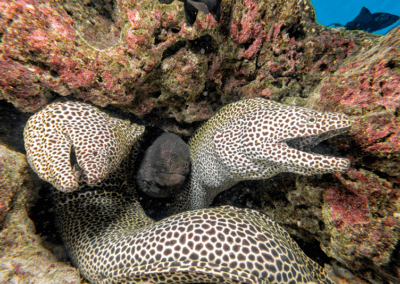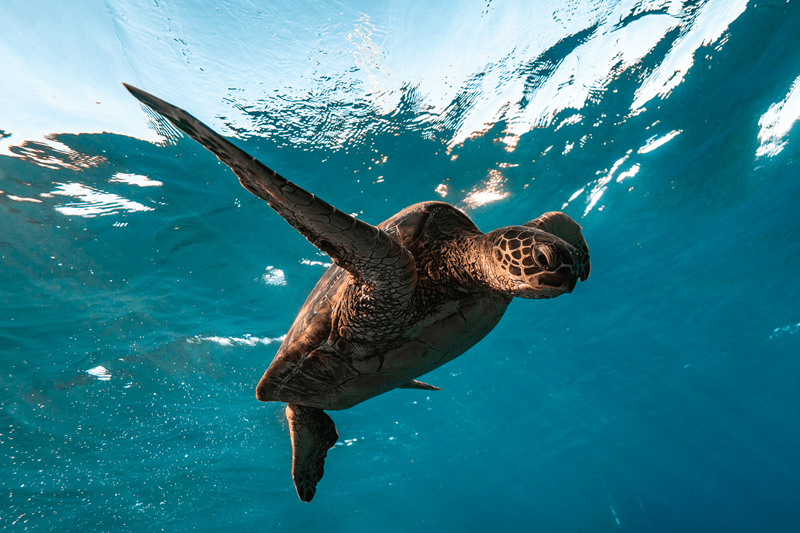Last Updated: October 23, 2025
This Maui fish identification guide covers 14 common reef fish species—with photos, quick ID tips, and exactly where to see tropical fish (Molokini Crater, Honolua Bay, Black Rock, Turtle Town).
These reefs across the Hawaiian Islands teem with life, from small invertebrates and sea urchins to brightly colored reef fish gliding above a sandy ocean floor and coral polyps waving in the gentle current. We also include respectful wildlife guidance so you can enjoy an incredible, low‑impact snorkel!
The Tropical Fish of Maui
Yellow Tang (Zebrasoma flavescens)
Bright, algae‑grazing surgeonfish common on shallow, sunlit reefs and coral gardens; often in loose groups near gentle surge.
How to ID- Solid lemon‑yellow, oval “disk” body; small pointed snout and smooth pectoral fin movement when grazing in shallow water.
- Often grazes in loose groups along shallow reef flats and slopes.
- Look, don’t touch or feed; keep fins off coral.
- Give turtles at least 10 ft / 3 m of space.
See it: 5‑hr Morning Molokini Tour
Learn more → Yellow Tang
Moorish Idol (Zanclus cornutus)
Slender, banded reef fish with a trailing dorsal ribbon; patrols reef edges and drop‑offs, usually solo or in pairs.
How to ID- Bold black‑white‑yellow bands with a long trailing dorsal streamer and a narrow white mouth used to peck at small invertebrates tucked into coral cracks.
- Slender snout for pecking in crevices.
- Move slowly; never chase for photos.
See it: Molokini Crater Snorkeling
Learn more → Best Coral Reefs in Maui (where they thrive)
Humuhumunukunukuapuaʻa (Reef Triggerfish)
Hawaiʻi’s state fish; a bold, wedge‑patterned trigger that cruises sandy patches by coral heads and will defend a nest if crowded.
How to ID- Beige body with bold black wedges, white bars, and electric blue/yellow accents.
- “Stop‑and‑go” swim; can lock into crevices with a dorsal “trigger.”
- If it flares fins or “tilts” at you, back away—triggers defend nests.
- Never feed fish; it harms reef behavior.
Learn more → Humuhumu (State Fish) Guide
Butterflyfish (multiple species)
Small, disk‑shaped coral specialists; look for paired fish pecking at coral and invertebrates around heads and ledges.
How to ID- Thin, disk‑shaped bodies with high dorsal fin; bright patterns.
- Quick cues: Raccoon, Longnose, Teardrop, Bluestripe (endemic), Milletseed.
- Hands off coral; keep a gentle kick to avoid stirring sand.
Learn more → Ornate Butterflyfish
Parrotfish (Scaridae; various)
Powerful grazers that scrape algae with a beak‑like mouth; you’ll hear the crunch and see “sand snow” where they feed.
How to ID- Blue/green/purple hues; fused “beak‑like” teeth scraping algae from rock/coral.
- Thick oval body; often seen biting and excreting sand.
- Observe quietly; never chase feeding fish.
Learn more → Parrotfish in Maui (Uhu)
Bluefin Trevally (Caranx melampygus)
A fast jack with electric‑blue fins; often shadows schools along the outer reef and strikes quickly near drop‑offs.
How to ID- Metallic body with blue‑spotted flanks and vivid electric‑blue fins- an ocean hunter that roams both reefs and the open water, somewhat reminiscent of the Red Sea jack species.
- Fast, cruising hunter along drop‑offs and reef edges.
- Give hunters room; don’t pursue schooling fish they’re chasing.
Learn more → Best Places to Snorkel in Maui
Lagoon Triggerfish (Rhinecanthus aculeatus)
Compact trigger that hugs shallow sand‑and‑rubble zones; watch for sudden darting into burrows when startled.
How to ID- Striking face “mask,” dark mid‑bar, and geometric pastel accents.
- Low, tight finning over sand and rubble; darts into holes when spooked.
- Triggers guard nests; maintain space and avoid sudden moves.
Learn more → Another common triggerfish: Black Triggerfish
Angelfish (Pomacanthidae; various)
Elegant reef cruisers with tall fins; commonly seen in pairs weaving above coral heads on gentle slopes.
How to ID- Tall, disk‑shaped fish with flowing dorsal/anal fins; bold patterns.
- Often cruise just above coral heads in pairs.
- Keep hands to yourself; never touch or stand on coral.
Learn more → Why Coral Gardens is great for angelfish
Hawaiian Cleaner Wrasse (Labroides phthirophagus)
Endemic wrasse that runs “cleaning stations”—hover and you’ll see larger fish lining up for a parasite pick‑off.
How to ID- Golden to yellow body with a bold black stripe running eye‑to‑tail.
- Seen “picking” parasites off clients at cleaning stations.
- Don’t block cleaning stations or reach toward fish—observe quietly.
Learn more → Turtle Town & cleaning stations
Hawaiian Sergeant (Abudefduf abdominalis)
Stocky damselfish with five bars; gathers near rocky points and surge channels, often over shallow reef.
How to ID- Silver body with five bold vertical bars; deep damselfish shape.
- Often near surge channels and rocky points in small schools.
- Skip the snacks—never feed fish; it disrupts reef balance.
Learn more → Reef fish you might see
Convict Tang (“Manini”) (Acanthurus triostegus)
Striped schoolers that “mow” algae carpets across the reef; big groups glide in unison in calm bays.
How to ID- Pale silver with bold black vertical stripes; oval “surgeonfish” body.
- Glides in large schools, lawn‑mowing algae across the reef.
- Give schools space; avoid splitting a feeding group.
Learn more → Convict Tang (Manini)
Boxfish (Ostraciidae; various)
Angular, armored swimmers that hover over coral and sand; males and females can look strikingly different.
How to ID- Rigid, box‑like body of hexagonal plates; “hovering” fin beats resemble the graceful motion of betta fish seen in home aquariums.
- Males vs. females often show very different patterns.
- Admire from a distance—never corner or handle wildlife.
Learn more → More Maui marine life
Hawaiian Green Sea Turtle (Honu)
Gentle grazers of algae; surface for air every few minutes—always give them space to swim and breathe.
How to ID- Large sea turtle with smooth, oval carapace; often seen cruising or surfacing to breathe.
- Stay at least 10 ft / 3 m away—in water and on land. Never touch or feed.
- Let basking/resting turtles be; give them a clear path to surface or shore.
See them respectfully: Turtle Town by boat
Learn more → Hawaiian Green Sea Turtles
Moray Eel (Muraenidae; various)
Nocturnal ambush predators peeking from crevices; the open‑close mouth is breathing, not aggression.
How to ID- Snake‑like body with head protruding from holes; rhythmic open/close mouth is breathing.
- Among lava ledges and coral heads across Maui (e.g., crater walls, boulder fields).
- Never reach into holes or under ledges; give eels generous space.
Learn more → Moray Eels in Maui
Snorkeling Maui: Where to Snorkel in Maui
Maui is not just a harbor for tropical fish but also a top destination for snorkeling enthusiasts. Snorkeling Maui is an experience, and an opportunity to dip oneself into a world unlike any other. Here are some of the best snorkeling spots in Maui, where you’ll find plenty of tropical fish and make lasting memories.
Molokini Crater (MLCD) — Boat only; morning is calmest
• Entry: Boat only (charter from Māʻalaea/Kīhei)
• Why it’s great: Protected reef, very clear water; common sightings: yellow tang, butterflyfish, Moorish idol, bluefin trevally
• Know before you go: No shore access; follow crew guidance in a marine reserve
• Learn more / Book: Molokini Crater Snorkeling Tour
Black Rock (Kāʻanapali) — Shore entry; check surf & currents at the point.
• Entry: Easy beach entry; stay clear of cliff‑jump area
• Why it’s great: Schools of sergeants; turtles cruise the edge
• Know before you go: Assess conditions; go with a buddy
Honolua Bay (MLCD) — Best in summer; long shoreline entry.
• Entry: Walk in from the path; rocky bottom—booties help
• Why it’s great: Protected marine reserve with abundant fish and coral
• Know before you go: Respect private lands/parking along highway; no fishing/feeding
Turtle Town (Mākena/Maluaka) — Boat or shore (varies with conditions).
• Entry: By boat on tours; some shore spots require calm seas
• Why it’s great: Frequent honu (green sea turtles), plus tangs & butterflyfish
• Know before you go: Stay ≥10 ft / 3 m from turtles—on land and in water
• Learn more / Book: Molokini Crater Snorkeling Tour

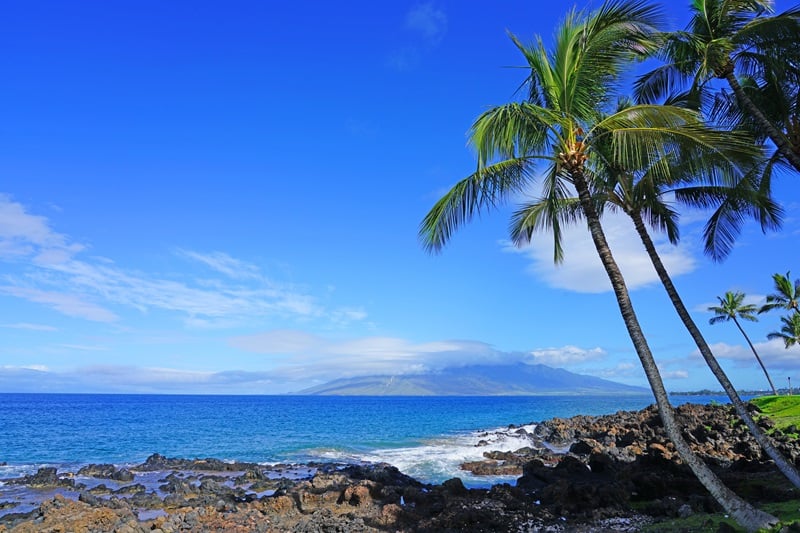
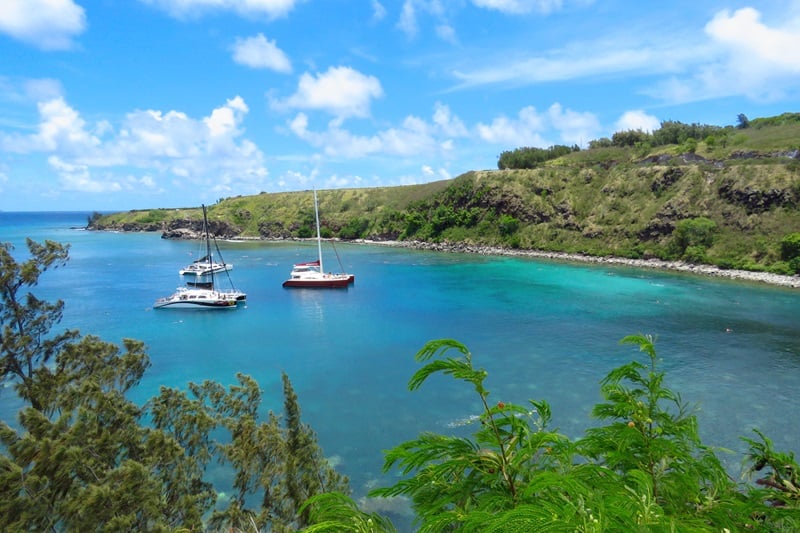
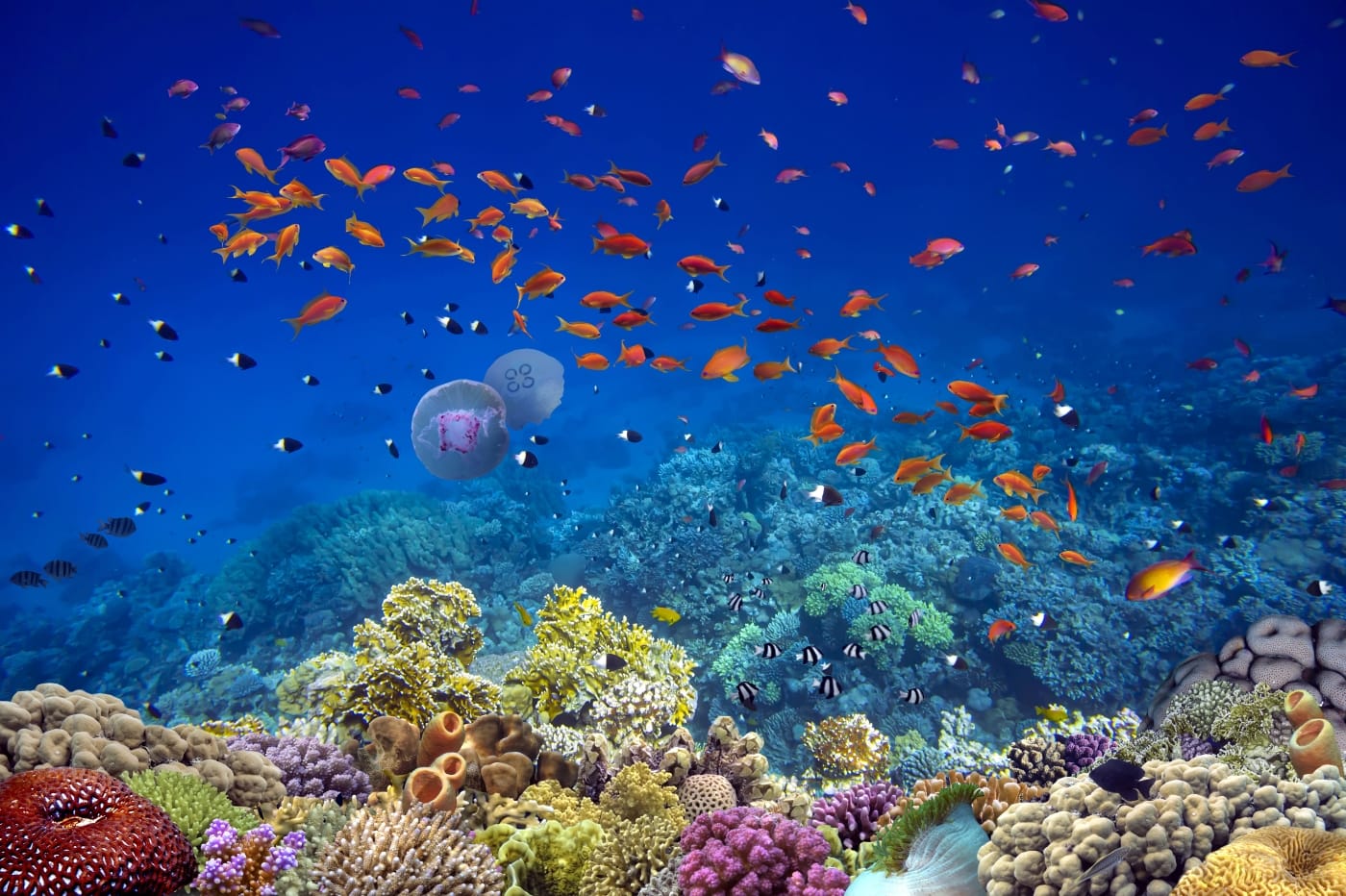
Maui Snorkeling Boat Tours
Ready to see Maui’s tropical fish for yourself? Join our Maui Snorkeling Tours for your snorkeling adventure! We offer all-inclusive tours in Maui and the iconic Molokini Crater. Envision snorkeling in clear waters, surrounded by Hawaiian green sea turtles, tropical fish, and exploring vibrant coral reefs. Our tours provide a unique snorkeling experience. We offer both Morning and Afternoon packages all year long.
Savor meals, enjoy snacks, and drink coffee, tea, juices, and soft drinks on board. We equip you with quality snorkeling gear—snorkels, fins, optical masks, and flotation belts. Added fun includes boogie boards, a 25-foot water slide, and swimming noodles. Our tours are full of fun! Choose a 5-hour trip to Molokini Crater with a second stop at Turtle Town. Enjoy a shorter 3-hour afternoon trip to Coral Gardens. We also offer Private & Group Charters for up to 65 passengers!
Snorkeling Maui!
Join a Maui Snorkeling Boat Tour and ride the slide into the crystal-clear waters and see the colorful tropical fish of Maui!
Tips for Snorkeling with Tropical Fish in Maui
- Respect the Ocean: Always remember that you are a visitor in the marine environment. Do not touch or step on the coral or harass the wildlife. Touching or stepping on coral can cause significant damage to these slow-growing structures.
Corals are alive, not stone, and contact can damage their fragile polyps, weakening the reef around them. Likewise, disturbing marine animals by chasing, touching, or feeding them can cause stress and interrupt their natural behaviors.
- Safety First: Safety should always come first when you’re in the water. Snorkeling is exciting, but it also has risks. The “Safety First” rule includes simple tips to keep your adventure fun and safe.
- Snorkel with a Buddy: Venturing into the ocean should never be a solitary endeavor. Snorkeling with a companion is not just about enhancing the experience through shared memories; it’s a critical safety measure.
- Monitor Ocean Conditions: The ocean is a dynamic environment, with conditions that can change rapidly. Before entering the water, it’s essential to observe the current, tide, and weather conditions. Strong currents and high waves can pose significant risks to snorkelers, potentially leading to exhaustion or disorientation. WHEN IN DOUBT, DON’T GO OUT!
- Heed Local Advice: Locals, including lifeguards, tour operators, and experienced snorkelers, possess invaluable knowledge about the specific snorkeling site. They can tell you which areas to avoid, the safest times to snorkel, and the best spots to see marine life.
- Preserve the Beauty: Use reef-safe sunscreen to protect the marine life and keep the waters pristine for future generations. Traditional sunscreens contain chemicals like oxybenzone and octinoxate, which have been shown to harm coral reefs and marine life. These chemicals speed up coral bleaching, which weakens corals and makes it harder for them to reproduce. This puts the whole reef at risk.
Reef-safe sunscreen lets visitors guard against the sun’s rays without adding damage to coral reefs and marine habitats.
Conclusion
Maui’s reefs rival its landscapes in beauty. Snorkeling is your ticket to an underwater rainbow of tropical fish and coral. Maui’s fish live free in the ocean, not in tanks like freshwater fish at home. They shine with color and amaze snorkelers at places like Molokini Crater and Turtle Town. Book your Maui Snorkeling Boat Tour today and discover the magic beneath the sea!
Maui Snorkeling Boat Tour
Join one of our tours today!


